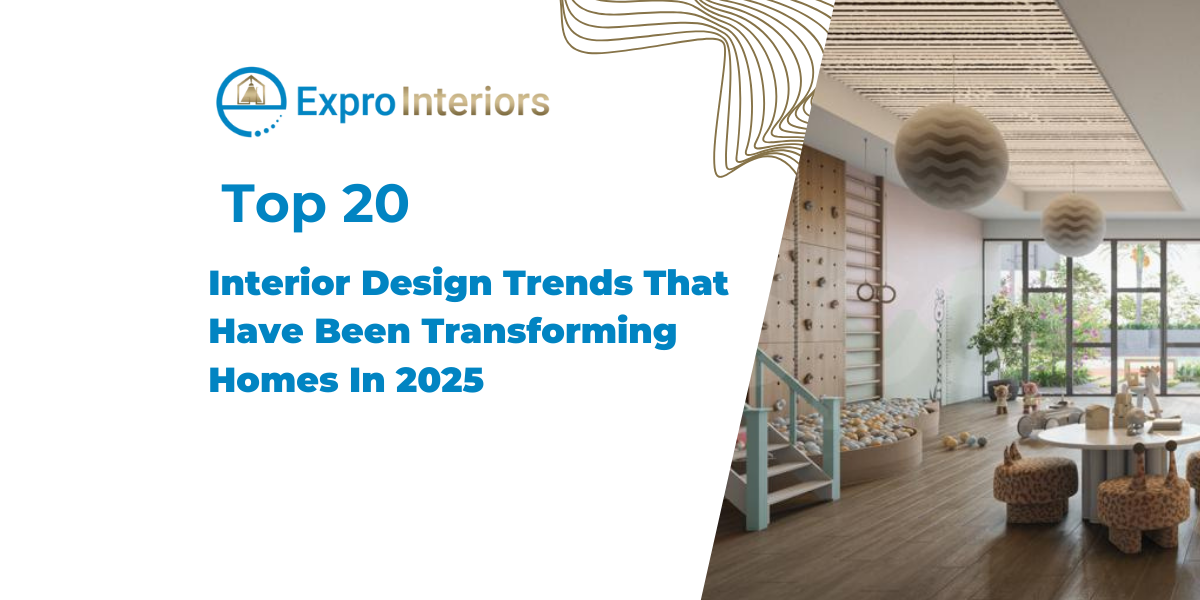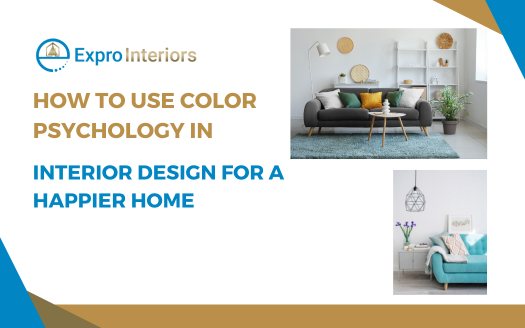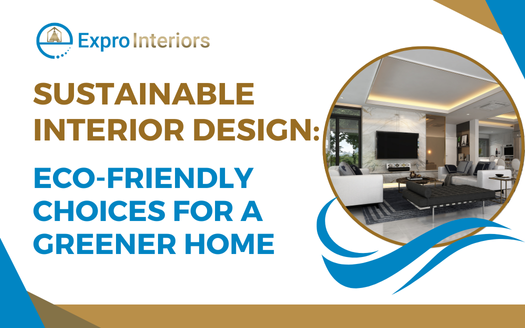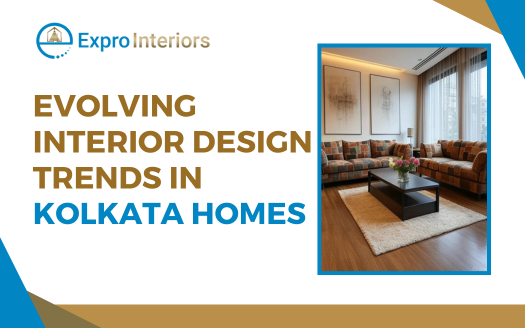Home design trends in 2025 are less about following strict rules and more about creating spaces that feel alive, meaningful, and in tune with how we actually live. People are rethinking their interiors not just as backdrops but as active parts of their daily routines.
A home today is expected to comfort, inspire, and even heal, which is why design has shifted from being only about looks to being about the entire living experience.
What makes this even more exciting is the sheer variety of directions people are taking. Some are drawn to bold statements and self-expression, while others seek calm and understated luxury.
Technology is quietly weaving itself into everyday life, and cultural identity is shaping choices in new ways. Rather than one dominant style, there’s a rich mix of ideas that allow every home to feel different and personal.
Table of Contents
ToggleInterior Design Trends That Are Here to Stay
Homes in 2025 are already showcasing some powerful design directions that have gone beyond being just interior design trends.
These ideas have taken root and are redefining the way people live, decorate, and experience their spaces. They combine beauty with practicality, showing how style and lifestyle go hand in hand.
Let’s explore the interior design trends that are already making a strong impact this year.
1. Nature-Infused Spaces
The biophilic design movement has matured this year, and homes are now blending greenery, natural light, and earthy materials more seamlessly than ever.
Large potted plants, indoor trees, and vertical gardens are no longer just accents. They are becoming structural features that define living spaces. Today –
- Indoor water features like small fountains or wall-mounted waterfalls are being used to bring a calming, natural flow into living areas
- Bamboo partitions and cane furniture are gaining popularity as eco-friendly design choices
- Natural clay wall finishes and lime plasters are replacing artificial paints for a healthier indoor environment
- Hanging planters and ceiling-suspended greenery are being integrated into open-plan living and dining areas
- Courtyard-style spaces inside homes are making a comeback, connecting interiors directly with fresh air and light
- Moss walls and living plant artwork are being embraced as decorative yet functional pieces that purify air
- Organic fabrics like linen, jute, and hemp are being used more in upholstery and curtains to align with earthy aesthetics
- Aromatic herbs like basil, mint, and lemongrass are being planted indoors for both fragrance and functional kitchen use
This approach also contributes to better air quality and a sense of calm that people crave in their living spaces.
2. Statement Ceilings
While accent walls had their time, in 2025 ceilings are the new design playground. Painted patterns, wood paneling, and even ceiling murals are making people look up in admiration.
Designers see this as a way of reclaiming the fifth wall of a room, making it just as important as the rest.
The beauty of statement ceilings lies in their versatility. For some, it means subtle additions like a pastel tone that contrasts with white walls. For others, it can be bold/ dramatic designs such as intricate wood carvings or metallic finishes. This flexibility allows homeowners to adapt the idea to their comfort level while still making a strong impression.
In smaller homes, bold ceilings create personality without eating into floor space. This makes them a smart choice for apartments and compact living, where walls and floors might be too restricted to showcase creativity.
It is a way to add depth and uniqueness while leaving the practical layout intact!
3. Multifunctional Furniture
The shift toward compact living has made flexible furniture a household essential. Sofas that transform into beds, coffee tables with hidden storage, and expandable dining sets are no longer niche buys.
Today, they are mainstream choices that work well in both small and large homes.
This trend isn’t just about saving space but also about sustainability. In place of multiple pieces, people are choosing smarter furniture that serves multiple purposes. This not only saves money but also reduces waste. Most importantly, it aligns with the eco-conscious mindset that many households are adopting.
Multifunctional furniture also supports a flexible lifestyle. A room can quickly shift from a living area to a workspace or guest room with a single change. That adaptability has become crucial as more people continue to blend their professional and personal lives within the same environment.
4. Sustainable Materials
Eco-friendly design has become a lifestyle choice that shapes everything from furniture to wall finishes. Bamboo, recycled glass, reclaimed wood, and organic fabrics are now at the forefront of material selection. These choices reflect a conscious effort to reduce carbon footprints while still creating beautiful interiors.
Manufacturers have responded by offering stylish and durable options that don’t compromise aesthetics.
For instance, recycled glass countertops are now designed to look sleek and elegant, rivaling even high-end granite. Similarly, bamboo flooring is being celebrated for its strength and warmth, while reclaimed wood brings character with its natural imperfections.
The growing demand for sustainable materials also shows a shift in consumer mindset. People no longer see eco-friendly as an alternative. In fact, it has become the standard, a necessary element for designing a home that feels modern and responsible at the same time.
5. Bold, Earthy Colors
Neutral grays are fading into the background, while deep earthy tones are dominating.
Colors like terracotta, olive green, ochre, and burnt sienna ground a space and create a cozy and intimate atmosphere. These shades have a timeless quality that makes them easy to integrate into any style of home.
One reason for their popularity is the emotional connection they provide. Earthy tones bring warmth and familiarity, often reminding people of natural landscapes or rustic living. This emotional pull makes homes feel safe and nurturing, which is a priority in uncertain times.
These colors also offer incredible versatility. They can be used as dramatic backdrops or subtle accents depending on the desired mood. When paired with natural textures such as rattan, linen, or clay, they create a balanced look that feels modern yet grounded in tradition.
6. Smart Home Integration
Smart homes are not futuristic anymore. They’re here and evolving fast. Lighting, climate control, security, and even kitchen appliances are seamlessly integrated through voice commands or apps.
- Smart thermostats are helping cut energy bills
- Automated blinds are responding to sunlight throughout the day
- AI-assisted appliances are personalizing cooking and cleaning routines
The appeal lies in convenience, efficiency, and a touch of luxury that makes everyday living smoother.
7. Curved Furniture and Soft Edges
Sharp angles are giving way to soft and rounded designs. Sofas with curved backs, oval dining tables, and even circular shelving systems are adding flow and comfort to interiors. What used to be considered retro has now evolved into a modern approach that softens the overall look of a room.
Rounded edges create a sense of relaxation and movement. They make spaces feel approachable and less rigid. Rooms appear more fluid and organic when they embrace these softer lines, which is why designers are incorporating curves into both large furniture pieces and subtle details.
Curved designs also encourage better space utilization. For example, rounded sofas can make small living rooms feel larger by avoiding harsh divisions, while oval tables often allow for easier seating arrangements.
8. Texture Layering
One of the most noticeable design approaches in 2025 is layering different textures. Mixing rough stone with smooth velvet, matte walls with shiny metallics, or wool rugs with glass tables creates richness and depth in interiors. It is no longer about matching everything but about combining contrasts that make spaces feel alive.
The appeal of texture layering lies in the sensory experience. People are drawn to interiors that don’t just look beautiful but also feel engaging to touch and explore. This creates an environment that stimulates more than just the eye and brings warmth and dimension into everyday spaces.
Another advantage is versatility. Homeowners can experiment with texture layering without making permanent changes. Adding throws, cushions, rugs, or small decorative pieces in different finishes can transform a room instantly without requiring major renovations.
9. Local Craftsmanship
Artisanal and locally crafted pieces are becoming the soul of many homes. They bring a sense of individuality that mass-produced décor cannot match.
More people are turning to regional artisans for handmade furniture, pottery, rugs, and lighting that feel unique and personal. These items make a home stand out and carry stories that matter.
Supporting local craftsmanship is also a way of giving back to the community. When you buy a handwoven rug or a carved wooden chair from a neighborhood artisan, you are helping preserve traditions and support small businesses.
Every piece becomes more meaningful because it connects your home to real people and their craft.
In Kolkata, this trend feels especially close to heart. Homeowners are bringing in Shantiniketan leather art, Bishnupur terracotta, and Bengal cotton dhurries to decorate their spaces.
A wooden table made by a Kumartuli carpenter or hand-painted Shola pith lamps can transform a room with local character. These choices add beauty, and also celebrate Bengal’s artistic heritage right inside your home.
10. Maximalist Personalization
Minimalism had a long run, but maximalism is making homes feel alive again. People are layering art, books, eclectic furniture, and bold décor items that tell stories rather than hiding them away. Instead of empty walls and clean surfaces, the focus is now on creating a vibrant space filled with personality.
The charm of maximalism lies in its freedom. Homeowners are encouraged to break away from rigid rules and mix patterns, colors, and textures in ways that speak to them personally.
No, this does not mean clutter but intentional curation of objects that carry meaning. Every item has a place because it represents a part of the homeowner’s identity.
As a result, homes feel more welcoming and dynamic. Guests can see the owner’s personality reflected in their décor choices, from vintage collections to travel souvenirs.
Interior Design Trends On Their Way
Homes are evolving fast, and while many interior design trends have already found their place, others are just beginning to surface.
These are the ideas designers predict will define the rest of the year and beyond. They reflect growing interests in well-being, technology, and cultural shifts, giving us a glimpse into what’s next for interiors.
11. Wellness-Centered Rooms
Health and wellness are no longer limited to gyms and spas.
Homeowners are starting to dedicate entire rooms to wellness practices such as yoga, meditation, and even sound therapy. Instead of squeezing exercise equipment into a corner, people are carving out intentional wellness zones.
These spaces often integrate calming colors, natural light, and acoustic designs that promote relaxation.
Some even use smart lighting that shifts with your body’s circadian rhythm to regulate sleep and focus. Wellness-centered rooms are expected to become a must-have in luxury homes and eventually filter into smaller apartments through creative layouts.
This interior design trend is more about lifestyle than design alone. As more people prioritize mental and physical health, homes are transforming into spaces where rest, mindfulness, and movement hold as much importance as work and social activities.
12. Hidden Tech
While smart homes are everywhere, the next step is making that technology invisible. Homeowners want the convenience of automation without the visual clutter of gadgets and screens.
Designers are responding by creating spaces where technology blends seamlessly into the architecture. For example,
- Televisions that roll up into furniture when not in use
- Mirrors that double as smart displays for news, weather, or fitness tracking
- Kitchen counters with built-in touchscreens for recipes and entertainment
- Beds with hidden climate-control systems that adjust temperature while you sleep
- Desks with concealed cable management and pop-up power outlets
- Wardrobes with built-in dehumidifiers and lighting that activates automatically when opened
- Bathroom mirrors with integrated LED lighting and anti-fog features
- Wireless charging built directly into tabletops
- Speakers hidden in walls or ceilings
The future of home tech is discreet. It won’t shout for attention but will work quietly in the background, leaving the interiors uncluttered and timeless.
13. Retro-Futurism
Retro-futurism is about taking design cues from the 60s, 70s, and 80s and updating them with modern finishes and technology.
Think of bold patterns, chrome accents, and playful shapes balanced with sleek minimalism.
This isn’t kitschy revival but a reimagining. For example, neon lighting is returning, but in more sophisticated formats like subtle LED strips that highlight architectural details.
Similarly, furniture inspired by mid-century design is being reintroduced with updated fabrics and ergonomic comfort. It feels familiar yet forward-looking, giving homes a creative and slightly nostalgic energy.
14. Mood-Based Lighting
Lighting is evolving from functional to emotional. The upcoming trend is customizable lighting systems that adapt to mood, time of day, or activity. Rather than one ceiling light, homes will rely on layered setups that include warm ambient tones, task lighting, and decorative features.
Homeowners are embracing lighting that can shift from bright and energizing in the morning to soft and soothing in the evening. Smart controls make this transition effortless. They allow people to create the right atmosphere with a single tap or voice command.
This flexibility makes rooms multifunctional. A dining area can transform into a romantic setting for dinner, then a lively space for hosting friends, all with the right lighting adjustments.
15. Quiet Luxury
The upcoming wave of interiors is all about understated elegance. Subtle luxury avoids flashy details and focuses on timeless quality, soft color palettes, and carefully chosen materials.
The appeal lies in creating homes that feel elevated without being overwhelming. It is not about showing wealth but about investing in fewer yet better things that stand the test of time. This makes quiet luxury both aspirational and sustainable in the long run.
It’s a style that whispers rather than shouts. People are gravitating toward interior design trends that make them feel at peace and enveloped in comfort.
16. Interactive Walls
Walls are no longer static surfaces. The trend that is starting to emerge in 2025 is the idea of interactive walls. These are surfaces that double as storage, media screens, or even writable boards.
Families are using magnetic paint, digital projections, or modular shelving to bring walls to life.
In creative homes, kids’ rooms may feature chalkboard or whiteboard walls, while living rooms could include projection walls that turn into mini-theaters. Some advanced designs are experimenting with flexible wall panels that can be reconfigured depending on need.
This is part of a bigger shift toward homes that adapt with us.
17. Cultural Storytelling
Another strong upcoming direction is the use of interiors to tell personal or cultural stories.
Homeowners are bringing heritage, traditions, and family narratives into their décor through art, textiles, and heirloom furniture.
Unlike the globalized look of earlier years, cultural storytelling is highly individual.
It could be a rug handwoven in a family’s village, or artwork passed down through generations. Designers are encouraging people to showcase these stories rather than hiding them away.
18. Flex Kitchens
Kitchens are evolving into more adaptable spaces. They’re doubling as social zones, workspaces, or even wellness hubs. Flex kitchens prioritize modular designs, movable islands, and clever storage that keeps the area functional for multiple uses.
For example, a kitchen island might have built-in charging stations for work-from-home setups, while retractable counters allow quick transitions from cooking to entertaining. Some upcoming designs are even introducing pocket doors that can hide entire sections of the kitchen when not in use.
19. Soundscaping
Noise has become one of the biggest disruptors in modern living, and soundscaping is the emerging solution! This interior design trend focuses on designing spaces with acoustics in mind, whether through materials, layouts, or technology.
Walls are being fitted with panels that reduce noise while doubling as decorative features, giving rooms a polished look. Soft furnishings like rugs, curtains, and textured textiles are also being chosen for their ability to absorb sound and make spaces feel quieter.
To complete the experience, many homes are adding smart speakers programmed with ambient nature sounds, creating a calm atmosphere that helps with both relaxation and focus.
Soundscaping makes homes quieter, calmer, and more intentional. As people spend more time indoors, it’s becoming just as important as lighting and ventilation.
20. The Rise of Home Galleries
Art is moving from being a single focal point to becoming an immersive feature in homes. People are curating personal galleries, dedicating walls or entire rooms to showcase their collections. This goes beyond traditional paintings to include digital art, photography, and mixed-media pieces.
The upcoming wave of home galleries is not limited to the wealthy. Affordable prints, community artist collaborations, and digital NFT displays are making art collecting accessible to a wider audience. It gives every homeowner the chance to showcase creativity and passion in their living space.
Ultimately, this interior design trend reflects the desire for homes to feel expressive and unique.
Bring Your Vision to Life, Stay on Top of Trends with Expro Interiors
At Expro Interiors, we know your home should feel like it’s truly yours. That’s why we listen to your ideas, your lifestyle, and the little details that matter most to you.
Whether it’s adding warmth with natural textures, creating a calm corner to unwind, or building a space that adapts to your everyday needs, our goal is to make design feel personal and effortless.
Ready to see how your home can reflect your story? Reach out to Expro Interiors and let’s create a space you’ll love coming back to every day.





